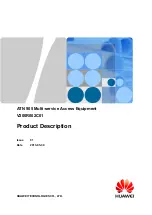
69
Firewall
: A configurable program or hardware device that filters information coming to
your private network or computer from the Internet. If a firewall flags a packet of
information, it does not get through to your network or PC.
Firmware:
Programming that is inserted into a device’s read-only memory (ROM) to
become a permanent part of the device. Firmware upgrades are often provided to
upgrade or improve a hardware device.
Idle Timeout
: A pre-configured amount of time after which an Internet connection will
automatically disconnect if there has been no activity on the Internet.
Infrastructure Mode
: An 802.11 networking mode where wireless devices communicate
through a wireless access point, instead of directly with each other (Ad Hoc mode).
IP Address
(Internet Protocol Address): A unique number that identifies a device on a
network. IP addresses are expressed in decimal form as four numbers between 0 and 255
that are separated by periods. (Example: 192.168.2.1) See also: Dynamic IP Address, Static
IP Address, Public IP Address, Private IP Address.
ISP
(Internet Service Provider): A company that provides individuals or businesses with
access to the Internet.
ISP Gateway Address
: The IP address for the Internet router located at the ISP's office.
Your ISP can provide you with this address, if needed.
LAN
(Local Area Network): A group of computers and devices connected together in a
relatively small area (such as a house or an office).
MAC Address
(Media Access Control Address): A unique number assigned by the
manufacturer to any Ethernet networking device (such as a network adapter) that allows
the network to identify it at the hardware level. Also known as the physical address or
Ethernet number.
MTU
(Maximum Transmission Unit): The largest physical packet size (in bytes) that a
network can transmit. Any messages larger than the MTU are divided into smaller
packets before being sent.
NAT
(Network Address Translation): A process that allows a single public IP address to
represent several private IP addresses when accessing the Internet. This allows multiple
users on a network to share an Internet connection without having to purchase multiple
IP addresses from an ISP.
Network Mask:
See Subnet Mask.
NIC
(Network Interface Card): A circuit board or card that is installed inside a computer
or network device so that the device can be connected to the Internet. Also known as a
network adapter.
Physical Address:
See MAC Address.
Ping of Death Attack:
A denial of service attack where a hacker sends an IP packet
larger than the maximum size specified by IP protocols, causing the computer or server
to crash. See also: Denial of Service.
Summary of Contents for BR455GWDC
Page 76: ...Revised October 22 2003...






































